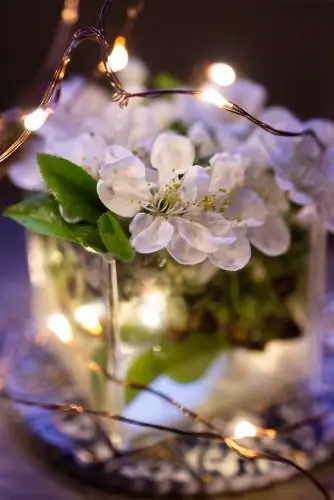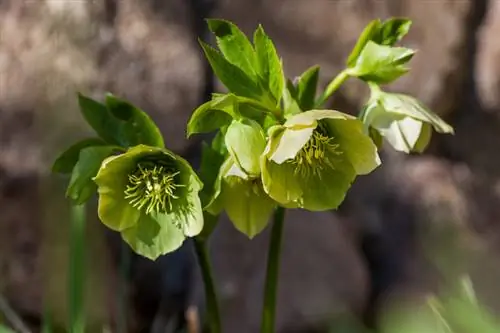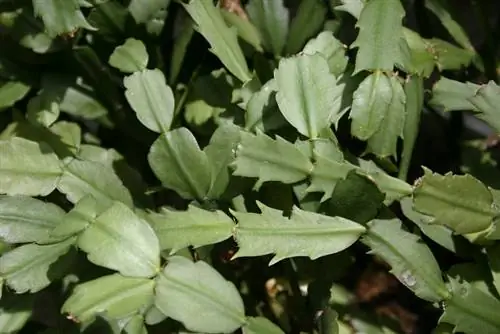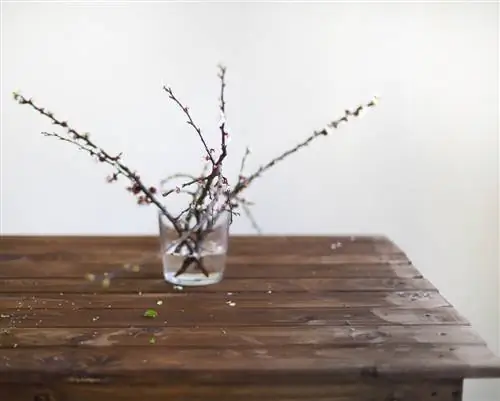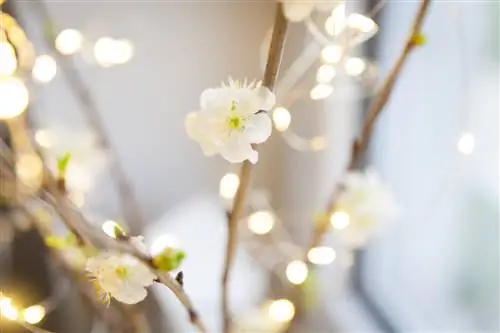- Author admin [email protected].
- Public 2023-12-26 14:17.
- Last modified 2025-06-01 06:02.
Barbara branches are the synonym for lived customs and picturesque blossoms in the middle of winter. Over centuries and across all liturgical boundaries, the traditional tradition has retained its magic to this day. This guide explains when and how to properly cut Barbara branches and get them to bloom. Immerse yourself here in the colorful dance of worldly and spiritual meanings that surround the historical custom.

What are Barbara branches and when are they cut?
Barbara branches are branches of flowering trees that are cut on December 4th, St. Barbara's memorial day, and placed in water to bloom at Christmas. Traditionally, cherry tree branches are used, but branches from apple, plum trees or ornamental bushes are also suitable.
- Barbara branches are traditionally cut and placed in a vase with water at sunrise on Saint Barbara's Day, December 4th
- With a bit of luck, the branch will bloom right at Christmas time
- Cherry branches are traditionally cut, but other fruit trees such as apple or plum trees or branches of magnolia, cornelian cherry or other beautifully flowering trees are also suitable
- After cutting, the branches should be placed in the freezer for 24 hours, then in a cool place until they show the first buds and only then in the final location
What are Barbara branches?
Barbara branches are branches of fruit trees and other flowering plants that are cut on December 4th according to an old tradition. On this day, the Roman Catholic and Greek Orthodox Churches celebrate the feast day of St. Barbara. The traditional custom is based on the hope that the branches will be in full bloom at Christmas and promise people happiness. For this purpose, they are displayed in a vase on a windowsill or in the middle of the apartment.
Buds on Saint Barbara, there are magnificent flowers for Christmas.
Which branches are suitable?
Traditionally, the branches of cherry trees serve as Barbara branches. Depending on the region and customs, a variety of tree species act as suppliers for the magical flowering branches at Christmas. As a rule of thumb, any hardy tree that naturally blooms in the spring before its leaves emerge is suitable for the Barbara branch. The following table lists popular trees and shrubs that are often cut on St. Barbara's Day:
| Name | botanical name |
|---|---|
| Cherry/sweet and sour cherry | Prunus avium/Prunus cerasus |
| Apple/Crabapple | Malus |
| Plum, plum | Prunus domestica |
| Cornelian cherry | Cornus mas |
| Blackthorn, sea buckthorn | Hippophae rhamnoides |
| Magnolia | Magnolia |
| Goldbells | Forsythia |
| Broom, noble gorse | Cytisus |
| Japanese ornamental cherry | Prunus serrulata |
| Magic Haze | Hamamelis intermedia |
| Winter Jasmine | Jasminum nudiflorum |
Trees and shrubs that boast decorative fruits at the beginning of December are highly valued as Barbara branches. A representative example are medlar branches (Mespilus), which on St. Barbara's Day bear spherical, orange-brown apple fruits decorated with distinctive, pointed sepals. This has the special advantage that these Barbara branches have a natural decoration in their luggage. This underlines the decorative value in the vase and ideally bridges the waiting time for the flower show at Christmas time.
When is the traditional cutting time?
Traditional customs dictate that Barbara branches only bloom if they are cut at the right time of day on December 4th. The best time is before sunrise, ideally after a frosty night. Anyone who misses this appointment will have to wait until the Vespers chimes for the evening prayer on St. Barbara's Day before cutting.

The Barbara branch should be cut on December 4th
Cut Barbara branches correctly - this is how it works
Every year on December 4th there is a lot of activity in gardens, orchards and forests. On this day, crowds of plant lovers are out and about cutting Barbara branches according to traditional tradition. In order for the hope of colorful flowers for Christmas to be fulfilled, it is important to have a good eye and an expert cut. How to cut a Barbara branch correctly:
- Best tool: freshly sharpened scissors (€9.00 at Amazon) with bypass mechanism
- Suitable branches: young, he althy wood with round, swelling buds
- Optimal intersection: just above an outward-facing eye, so that the gap closes in spring
The frequent recommendation to tap the ends of branches with a hammer falls on deaf ears among experienced hobby gardeners. This measure is said to improve water absorption. The opposite is the case, because the hammer destroys important pathways in the wood. It is better to cut at an angle or make a 0.5 cm deep cross cut into the end of the branch with a sharp, disinfected knife. Alternatively, thinly cut a little bark from the end of the branch, which increases the area for water absorption.
Tip
You don't need your own garden to celebrate the traditions surrounding Barbara branches. At the beginning of December you can buy suitable branches at weekly markets, in garden centers or online, for example in the Dehner online shop. You can find out where you can get Barbara branches for free in the regional press. Giving away suitable branches is a popular form of customer advertising and city marketing.
How to make Barbara branches bloom

The Baraba branch should be nice and bright
Timely and expert cutting marks important milestones on the way to blooming Barbara branches at Christmas. In order for your hopes to actually come true, you should treat the cut branches properly. How to get Barbara branches to bloom on time:
- After cutting, place in the freezer compartment of the refrigerator for 24 hours
- the following day place in a bowl of lukewarm water
- on the third day place in a vase with room temperature water
- First choose a cool, bright room as a location until the first buds swell
- After the step-by-step preparation, place the vase in the final location
Barbara branches in the vase want a place that is flooded with light and without direct sunlight. Pleasant room temperatures between 20 and 23 degrees Celsius are ideal. When choosing a location, please make sure that no rising heating air causes the branches to dry out prematurely.
Care for Barbara branches in an exemplary manner - tips & tricks
Fresh water at room temperature is the be-all and end-all of Barbarazweigen's care program. Please change the water completely every 2 to 3 days. Check daily whether the water level in the vase has lowered so that you can water the branches if necessary. It is advantageous to add liquid flower food for a complete supply of nutrients. When changing the water, please check the ends of the branches. Rotten, soft areas are a good reason to trim a Barbara branch a few millimeters. The uncomplicated care is rounded off with a daily gentle spray of low-lime water, which compensates for the low humidity in heated living spaces.
Excursus
Arrange and decorate Barbara branches
Flowering Barbara branches in the vase spark creative ideas to enhance the picturesque spectacle with beautiful decorations. Arrange the branches with a flowering amaryllis, which naturally blooms in winter. A few blooming Christmas roses are happy to take on the role of a decorative escort. Of course, Christmas accessories should not be missing in the artistic combination, such as glittering Christmas tree balls, colorful stars and elegant pendants.

Barbara branches do not bloom - 3 common mistakes
Do your Barbara branches consistently keep the longed-for flowers under wraps? Then there is a common mistake behind it. Three typical mistakes in the care of Barbara branches with tips for prevention sum up the following lines:
No cold stimulus
If Barbara branches do not bloom, the most common cause is a lack of cold stimulus. As the climate warms, it is far too mild in late autumn because Indian summer lasts for several weeks. No sign of the first frost anywhere. In order for a cherry branch or other fruit tree shoot to lay its buds, temperatures below freezing are essential. Instead of foregoing the flower festival in winter, simply simulate a cold shock. To do this, place the cut branches in the freezer compartment of the refrigerator for a day.
Abrupt move into the apartment
A seamless move from the wintry garden to the comfortably warm apartment causes Barbara's branches to wither beyond hope. As a result, established buds fall by the wayside and all hopes of Christmas flowers are gone. You can effectively prevent this hassle by initially placing Barbara branches in a vase with lukewarm water in a cool, slightly temperate location. In real spring, temperatures don't break 20 degrees overnight. Regular spraying with soft water increases flowering and cushions the threat of drought stress.
Mistake number three results from an unsuitable choice of tree species. It is not an ironclad rule that only cherry branches are suitable for customs. If you live in a region where cherry trees have a hard time blooming profusely, please choose regional, flowering wild trees such as blackthorn, cornelian cherry, elderberry or witch hazel.
Barbara branches and their tradition
The tradition of blooming Barbara branches in the middle of winter is based on a medieval legend. Barbara was the beautiful daughter of the we althy Turk Dioscurus. To preserve her chastity, he locked his daughter in a tower when he traveled. The incarceration could not prevent Barbara from converting to Christianity and being baptized. Her father was so horrified by this that he handed his daughter over to persecution of Christians in 300. Under torture, Barbara was supposed to renounce her new faith again.
On the way to prison, a cherry branch got caught in Barbara's clothes. She lovingly cared for this branch in her cell with water from her drinking bowl. Legend has it that the branch bloomed on the day of her martyrdom, even though it was a bitterly cold winter. The father showed no mercy to his steadfast daughter and is said to have beheaded her himself. Since then, Barbara has been revered as the patron saint of the dying and is one of the 14 helpers in need in the Catholic faith. In memory of the courageous young Christian, the custom of flowering branches in winter is still celebrated today.
Magic oracle - correctly interpreting Barbara branches

A luxuriantly blooming Barbara branch is said to predict a bountiful harvest
Blossoming Barbara branches bring good luck. The first records from the early Middle Ages already indicate this belief. Since then, the magical branches have functioned in popular belief as oracles for a variety of hopes. We present some classic interpretations in more detail below:
Marriage Oracle
Single girls hang a piece of paper with the name of an admirer on each Barbara branch. Whoever's branch opens its flowers first will soon be the bridegroom.
Harvest Oracle
Farmers make a direct connection between the number of flowers on the Barbara branch and the harvest next year. A lushly blooming branch in winter gives the whole family hope for a rich harvest. If only a few buds open or no buds open at all, this is associated with bad premonitions of a bad harvest.
Hopeful lottery players have discovered Barbara branches as an oracle. For this purpose, 49 branches are cut on St. Barbara's Day and placed in water. Each branch receives a number card. In the period that follows, the ostrich is watched like a hawk. The first 6 branches with flowers reveal the winning numbers for next year.
Frequently asked questions
When do you put up Barbara branches?
Follow traditional customs to the letter and cut Barbara branches on December 4th, St. Barbara's memorial day. Of course, this is not a fixed date. To enjoy fresh spring flowers in winter, you can cut branches from flowering trees on another day at the end of November/beginning of December, ideally after the first frost. Place the branches in lukewarm water for one night and then place them in a vase with fresh, room temperature water in a bright location.
Which branches are suitable as Barbara branches?
In addition to the traditional cherry branch in the Barbara legend, numerous other woody species have the potential to become a Barbara branch. Basically, you can use branches from any spring-flowering tree or shrub. These include fruit trees, such as apples, plums, plums and pears. Among the ornamental shrubs, forsythia and broom have proven themselves well as Barbara branches. From the natural garden, the branches of elderberry, willow, cornelian cherry, blackthorn or hazelnut find their way into the winter home to shine with fragrant flowers or distinctive catkins at Christmas time.
When do Barbara branches bloom?
Barbara branches traditionally bloom at Christmas. Of course, the wintry magic trick only works under certain conditions. Branches of early-flowering fruit trees are cut after they have experienced a cold stimulus. A lukewarm water bath makes branches think of spring and awakens the joy of blooming. Then place Barbara branches in a vase with water at room temperature. According to traditional custom, the right time is December 4th, the day of remembrance of the martyr Barbara. When regularly watered and sprayed with fresh water in a bright, warm location, Barbara branches bloom just in time for Christmas and spread a touch of spring.
Why aren't my Barbara branches blooming?
The most common cause is a lack of cold stimulus in late autumn. Cherry trees and other native flowering trees only produce their buds after they have been exposed to temperatures below freezing for at least one night. If the weather is too mild, you should put cut Barbara branches in the freezer for 24 hours. Furthermore, the flowers will not bloom if you move the branches from the cold outdoors into a well-heated room. Place Barbara branches in a vase with lukewarm water. Choose a cool, bright place as a location for the first few days, such as the bedroom.
Tip
Knowledgeable home gardeners use St. Barbara's Day for more than just cutting St. Barbara's branches. The window for trimming trees is open around December 4th. In particular, many local trees and shrubs cope well with rejuvenation pruning in winter because they are in a state of dormancy.

